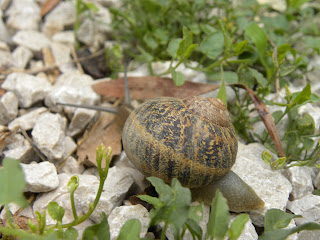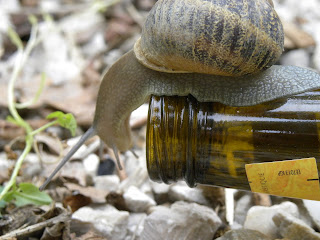Today's tale is about snails. You may recall that we (my husband and I) went to Scotland earlier in the summer and I said that I would give details later. Well we went to Paisley, Scotland so that my husband could attend a law conference. You may, quite understandably, be wondering what that might have to do with snails. Well I'll share some information on a famous case in English common law about a snail.
First though, what is a snail?
A "Snail is a common name which is applied to most of the members of the molluscan class Gastropoda that have coiled shells in the adult stage. When the word is used in its most general sense, it includes sea snails, land snails and freshwater snails. The word snail without any qualifier is however more often applied to land snails than to those from the sea or freshwater. Snail-like animals that naturally lack a shell, or have only an internal shell, are often called slugs, and land species that have only a very small shell (that they cannot retract into) are called semislugs." (Wikipedia)
I probably don't have to tell you that snails don't move very fast and thus are sometimes used as a symbol for laziness.
"In Christian culture, it has been used as a symbol of the deadly sin of sloth. Psalms 58:8 uses snail slime as a metaphorical punishment."
"Snails were widely noted and used in divination. The Greek poet Hesiod wrote that snails signified the time to harvest by climbing the stalks, while the Aztec moon god Tecciztecatl bore a snail shell on his back. This symbolised rebirth; the snail's penchant for appearing and disappearing was analogised with the moon."
"In contemporary speech, the expression "a snail's pace" is often used to describe a slow, inefficient process. The phrase "snail mail" is used to mean regular postal service delivery of paper messages as opposed to the delivery of email, which can be virtually instantaneous."Add to that, they are hated by gardeners because they seem to "graze" on the fresh new shoots of our favorite plants, and are much maligned indeed.
Here is my husbands synopsis of the famous case celebrated and discussed at the Paisley Snail Conference:
In August 1928 May
Donoghue went by tram from Glasgow to the small town of Paisley with a friend. In Paisley they went to the Wellmeadow Café
where her friend treated her to a ginger beer float. Mr. Minghella, the proprietor, brought a
glass with ice cream and poured some ginger beer from an opaque bottle into the
glass at the table. When May poured some
more ginger beer into the glass she claimed that the decomposed remains of a
snail appeared. In those days May would
have had no recourse – her friend had treated her, Mr. Minghella just poured
the ginger beer out of the bottle which he had purchased from Mr. Stevenson’s soft
drinks company and May had not bought the soft drink from Mr. Stevenson so she
had no contract with either of them.
However a law suit was commenced and a motion by Mr. Stevenson’s lawyers
to strike out the claim was dismissed but the Court of Session (Scotland’s
appeal court) allowed the appeal and dismissed the claim. May’s lawyers appealed to the House of Lords,
at that time the United Kingdom’s highest court. In May 1932 Lord Atkin allowed the appeal,
supported by 2 of the other 4 judges. He
said that when you manufactured a product you had to take reasonable care not
to injure your neighbour, who in law was anyone you could reasonably foresee
might be injured if you were negligent. (Donoghue vs Stevenson)
This simple case was
the beginning of a major change in the law in the Commonwealth as the courts
finally caught up with the reality that many products were now manufactured and
shipped across a country (in trains) and the users of the product dealt with
intermediaries, not the manufacturer.
The House of Lords’ decision opened up the whole area of product
liability and other areas of liability such as negligence of professionals. While there have been many important court
decisions, this case probably had the most wide reaching and long lasting
effect of any case in the Commonwealth.
Interestingly the case
never went to trial so it was never proved that there had been a snail in the
bottle. Mr. Stevenson died and his
executor settled the case with Ms. Donoghue.
The conference in
Paisley was held to celebrate the 80th anniversary of the House of
Lords’ decision. Many interesting papers
were presented dealing with the development of the law since the decision.
This way ..........
So with that in mind, how could a snail have gotten into a bottle of ginger beer. As an aside my husband tells me that the term "ginger" is used as a generic word for a soft drink or soda in Scotland.
So when I was in Province in the summer I took "a few" pictures of snails which seemed quite active early in the day.
Since the snails were quite cooperative I decide to try to reenact the alleged event so bear with me as the snail makes his way from the path and over the gravel ...
... to the bottle....
Well there seems to be a problem here, looks like a tight fit or .............
maybe not ......
Well they have a saying that in Scotland, the snails are so poor they can't afford houses! Maybe that explains it, but if they don't have houses then according to the previous description they are technically slugs not snails ... and that just doesn't have the same ring to it!
I hope you have enjoyed this tale about a very famous snail case. Oh, by the way, no snails were harmed in photographing this reenactment.
This week for a change of pace I painted something light and silly. A watercolour again, but this time of a frog, perhaps a frog prince, perhaps a prince frog. I call it "Who did you expect?"
Well thanks for hanging in through this moving tale. Happy Whimsy Wednesday.
Until next time ..........
























